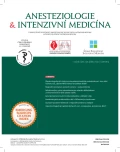Generalizovaný konvulzivní status epilepticus v dětském věku
Authors:
Š. Aulická 1; P. Aulický 2; K. Česká 1; K. Španělová 1; H. Ošlejšková 1
Authors‘ workplace:
Klinika dětské neurologie, Lékařská fakulta, Masarykova univerzita, Fakultní nemocnice Brno
1; Oddělení anesteziologie, resuscitace a intenzivní medicíny, Nemocnice Milosrdných bratří
2
Published in:
Anest. intenziv. Med., 29, 2018, č. 3, s. 139-147
Category:
Review Article
Overview
Generalized convulsive status epilepticus (GCSE) is the most common neurological emergency in children. It is defined as a generalized convulsive seizure lasting longer than 5 minutes. The infantile and particularly neonatal period is the high-risk period for development of GCSE. The most common etiology is febrile status epilepticus. GCSE is divided into four stages: early (5-20 minutes), established (20-40 minutes), refractory (>40 minutes), and super-refractory (>24 hours). A generalized convulsive seizure lasting up to 5 minutes is called impending GCSE. This corresponds with the time in which adequate seizure termination treatment should be initiated.
Management of GCSE consists of basic life support (the ABC) and administration of antiepileptic drugs which will stop the seizure. Identification and treatment of the cause of the status is equally important. All antiepileptic drugs should be administrated intravenously. First line treatment of early-stage GCSE includes benzodiazepines (diazepam or clonazepam). Second line treatment of established GCSE includes one of the non-benzodiazepine antiepileptic drugs: phenytoin, valproate, levetiracetam, phenobarbital or lacosamide. In the case of failure of first-line and second-line treatment, i.e. in the refractory GCSE stage, IV anaesthetic drugs (thiopental, midazolam, or propofol) are commonly used. General anaesthesia should be maintained for 24 to 48 hours and the depth of the anaesthetic coma should be monitored by continuous EEG. When treatment with IV anaesthesia for more than 24 hours is unsuccessful in controlling the GCSE, the condition can be termed super-refractory GCSE. This condition is associated with high morbidity and mortality.
keywords:
convulsive status epilepticus – refractory status epilepticus – children
Sources
1. http://www.uptodate.com/contents/clinical-features-and-complications-of-status-epilepticus-in-children
2. https://www.uptodate.com/contents/management-of-convulsive-status-epilepticus-in-children
3. Glauser T, Shinnar S, Gloss D, et al. Evidence-Based Guideline: Treatment of Convulsive Status Epilepticus in Children and Adults: Report of the Guideline Committee of the American Epilepsy Society. Epilepsy Currents. 2016;16:48. doi: 10.5698/1535-7597-16.1.48.
4. Trinka E, Cock H, Hesdorffer D, et al. A definition and classification of status epilepticus – Report of the ILAE Task Force on Classification of Status Epilepticus. Epilepsia. 2015;56:1515–1523.
5. Singh RK, Stephens S, Berl MM, et al. Prospective study of new-onset seizures presenting as status epilepticus in childhood. Neurology. 2010;74:636.
6. https://emedicine.medscape.com/article/1164462-overview#a2
7. Beghi E, Carpio A, Forsgren L, et al. Recommendation for a definition of acute symptomatic seizure. Epilepsia. 2010;51:671– 675. doi: 10.1111/ j.1528- 1167.2009. 02285.
8. Meldrum BS. Pathophysiology. In: A Textbook of Epilepsy. Eds.: Laidlaw J, Richens A, Oxley J. Churchill Livingstone. 1988;203–235.
9. Gaspard N, Foreman BP, Alvarez V, et al. Critical Care EEG Monitoring Research Consortium (CCEMRC). New-onset refractory status epilepticus: Etiology, clinical features, and outcome. Neurology. 2015;85:1604–1613. doi: 10.1212/WNL.0000000000001940.
10. Khawaja AM, DeWolfe JL, Miller DW, et al. New-onset refractory status epilepticus (NORSE)--The potential role for immunotherapy. Epilepsy Behav. 2015;47:17.
11. Howell KB, Katanyuwong K, Mackay MT, et al. Long-term follow-up of febrile infection-related epilepsy syndrome. Epilepsia. 2012;53:101.
12. Fox K, Wells ME, Tennison M, et al. Febrile Infection-Related Epilepsy Syndrome (FIRES): A Literature Review and Case Study. Neurodiagn J. 2017;57:224–233. doi: 10.1080/21646821.2017.1355181.
13. Glauser T, Shinnar S, Gloss D, et al. Evidence-Based Guideline: Treatment of Convulsive Status Epilepticus in Children and Adults: Report of the Guideline Committee of the American Epilepsy Society. Epilepsy Curr. 2016;16:48–61. doi: 10.5698/1535-7597-16.1.48. PMCID: PMC4749120.
14. www.epistop.cz
15. https://www.uptodate.com/contents/juvenile-myoclonic-epilepsy
16. Poddar K, Sharma R, Ng YT. Intravenous Lacosamide in Pediatric Status Epilepticus: An Open-Label Efficacy and Safety Study. Pediatr Neurol. 2016;61:83–86. doi: 10.1016/j.pediatrneurol.2016.03.021.
17. James L, Linda H, Paul K, et al. Guideline for the management of convulsive status epilepticus in infants and children. BC MEDICAL JOURNAL. 2011;53–56.
18. https://lifeinthefastlane.com/ccc/propofol-infusion-syndrome/
19. Nee-Hooi W, Priya N. Propofol infusion syndrome. Continuing Education in Anaesthesia, Critical Care & Pain. 2013;13:6.
20. Shorvon S, Ferlisi M. The treatment of super-refractory status epilepticus: a critical review of available therapies and a clinical treatment protocol. Brain. 2011;134:10.
21. Aroor S, Shravan K, Mundkur S, et al. Super-refractory status epilepticus: A Therapeutic Challenge in Paediatrics. Journal of Clinical and Diagnostic Research. 2017;11:SR01–SR04.
22. https://www.uptodate.com/contents/paraneoplastic-and-autoimmune-encephalitis#H2973236366
23. Broomall E, Natale JE, Grimason M, et al. Pediatric Super-Refractory Status Epilepticus Treated With Allopregnanolone. Ann Neurol. 2014;76:911–915.
24. Kenney-Jung DL, Vezzani A, Kahoud RJ, et al. Febrile infection-related epilepsy syndrome treated with anakinra. Ann Neurol. 2016;80:939–945.
25. Raspall-Chaure M, Chin RF, Neville BG, et al. The epidemiology of convulsive status epilepticus in children: a critical review. Epilepsia. 2007;48:1652.
26. Lambrechtsen FA, Buchhalter JR. Aborted and refractory status epilepticus in children: a comparative analysis. Epilepsia. 2008;49:615.
27. https://www.uptodate.com/contents/treatment-of-neonatal-seizures
28. Nicolai J, van Kranen-Mastenbroek VH, Wevers RA, et al. Folinic acid-responsive seizures initially responsive to pyridoxine. Pediatr Neurol. 2006;34:164.
Labels
Anaesthesiology, Resuscitation and Inten Intensive Care Medicine Neurology Paediatrics General practitioner for children and adolescentsArticle was published in
Anaesthesiology and Intensive Care Medicine

2018 Issue 3
- Metamizole vs. Tramadol in Postoperative Analgesia
- Memantine in Dementia Therapy – Current Findings and Possible Future Applications
- Memantine Eases Daily Life for Patients and Caregivers
- Metamizole at a Glance and in Practice – Effective Non-Opioid Analgesic for All Ages
- Advances in the Treatment of Myasthenia Gravis on the Horizon
Most read in this issue
- Urgent infraglottic airway – cricothyroid puncture, cricothyrotomy and bougie-assisted cricothyrotomy (BACT)
- Generalizovaný konvulzivní status epilepticus v dětském věku
- Regional anaesthesia for shoulder surgery – new trends
- Corticosteroids in regional anaesthesia and analgesia – state of the art
